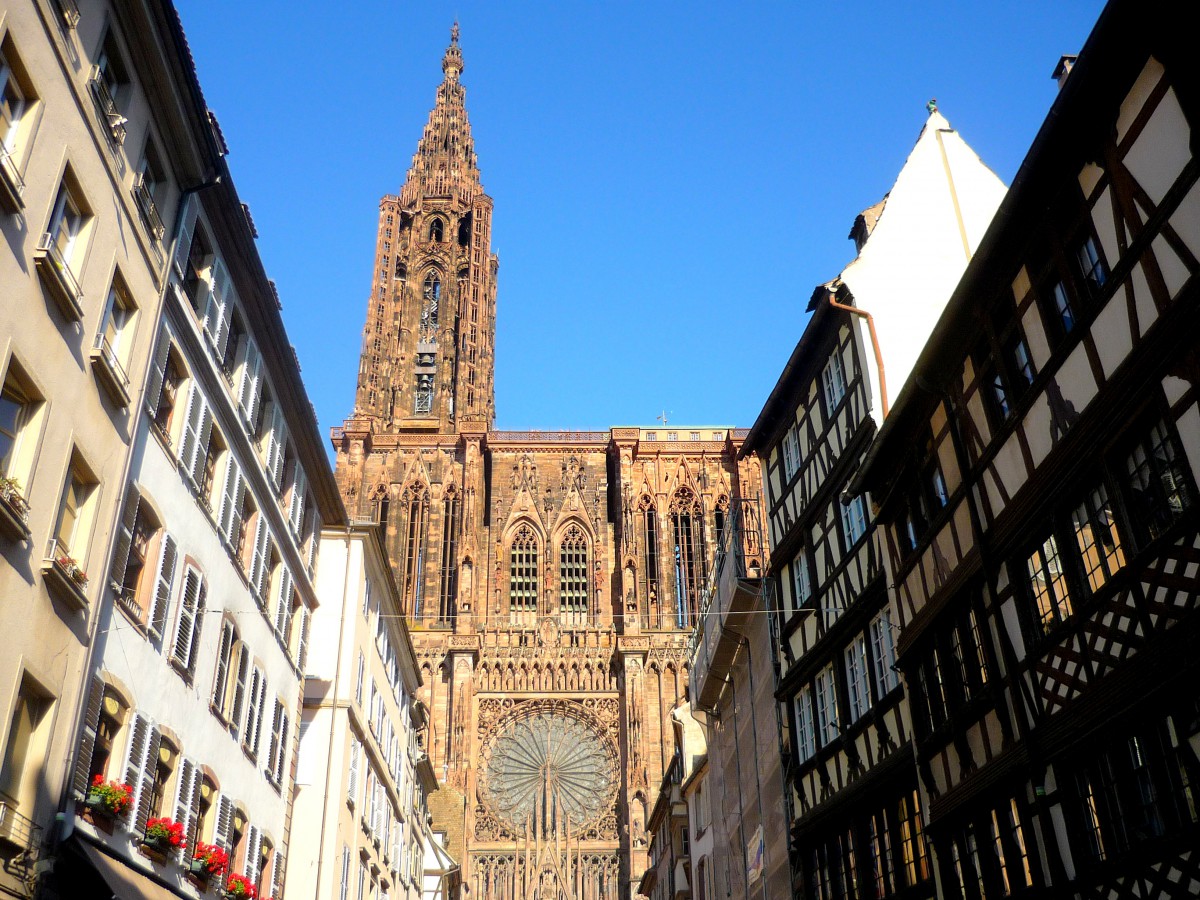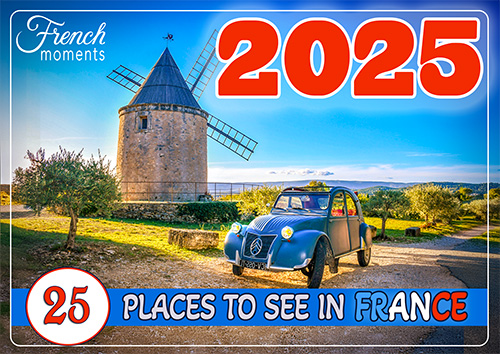Attracting around 4 million visitors yearly, Strasbourg Cathedral is the second most-visited cathedral in France after Notre Dame de Paris and well before those of Metz, Reims and Chartres. In 1839, Victor Hugo declared the cathedral a “gigantic and delicate marvel”. Let’s explore this masterpiece of Gothic architecture!
Exploring Strasbourg Cathedral
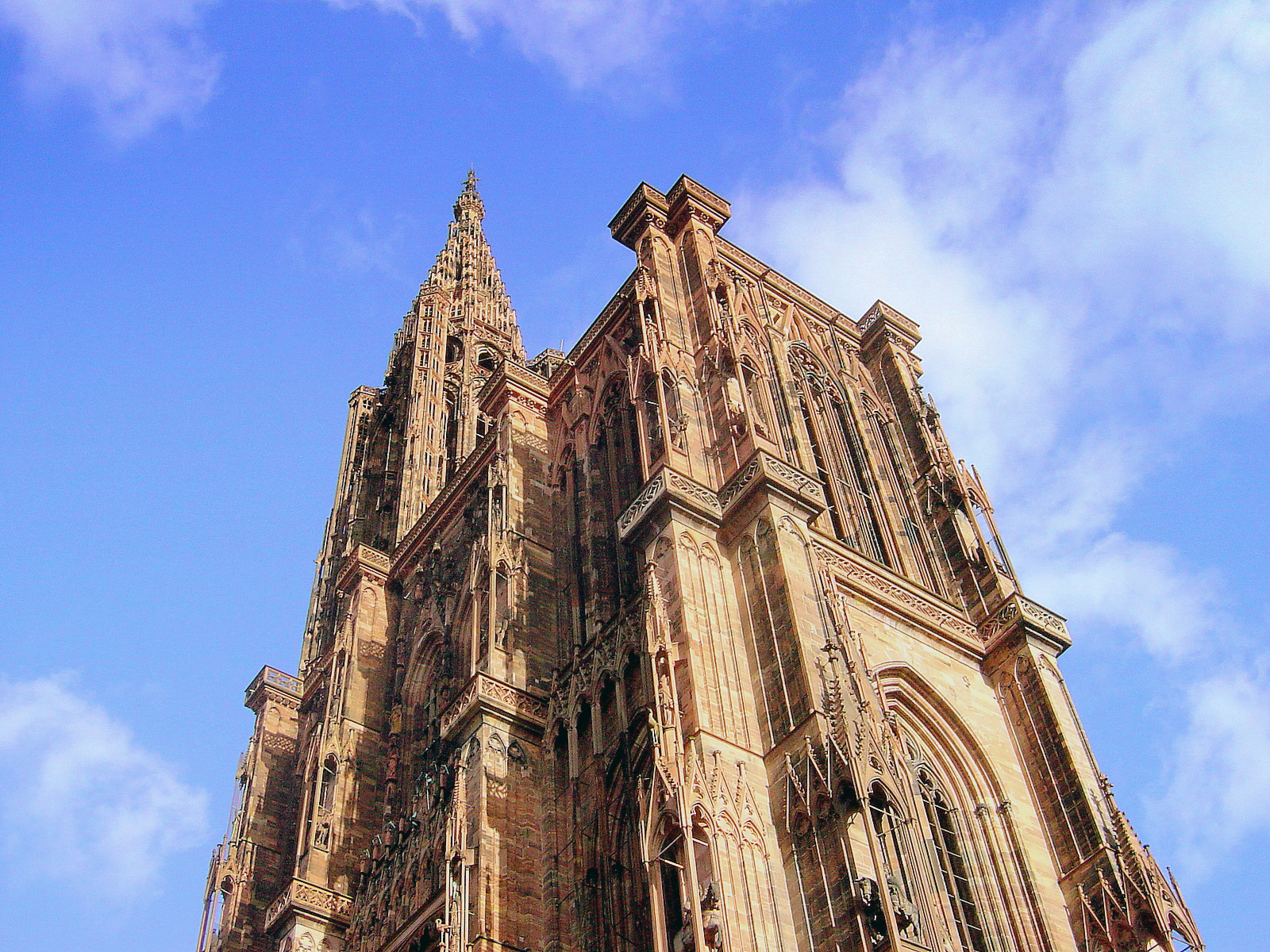
Recognisable from afar, thanks to its atypical allure, the Cathedral of Strasbourg is the undisputed emblem of the city and, at times, of the whole of Alsace.
Whether you take the autoroute from Paris or Mulhouse, its silhouette with the single bell tower surmounted by a spire is visible from afar, heralding the next on-ramp to the Alsatian capital.
Its 142-metre-high spire was the highest monument in the world from 1647 until 1874, and its height makes it the second-tallest cathedral in France after that of Rouen. It is a masterpiece of grace and lightness.

History of Strasbourg Cathedral
The current building was erected on the site of a 103 metre long old Romanesque basilica, commissioned in 1015 by the Bishop of Strasbourg, Werner of Habsburg, with the support of Emperor Henri II. This Ottonian-style wooden-framed building was destroyed by fire in 1176.
Construction of the current cathedral
Construction of the current cathedral began at the end of the 12th century by the Bishop of Strasbourg, Henry of Hasenburg. With the cathedral in Basle having been completed, the new one in Strasbourg would be even more glorious. The work was spread out over three centuries and was completed in 1439.
Sandstone from the Vosges was used in either pink or brown (pollution gave the cathedral its pink-grey colour). In German, the sandstone is called Sandstein, which means “stone of sand”, and is known in French as “grès”.
From Romanesque to Gothic styles
At first glance, the architectural contrast between the chancel and the façade is visible. Indeed, the chancel and the north transept began construction in Romanesque style.
With the arrival in 1225 of the team of a new foreman familiar with Chartres and Burgundy, it was decided to continue the works in the innovative gothic style of the time. As such, this style, already well-established in Ile de France, appeared in Alsace.
The architect of the Cathedral of Strasbourg built the most modern building of his time in the Holy Roman Empire. Moreover, its forms were primarily inspired by the Saint Denis Basilica, a new reference during the 13th century.
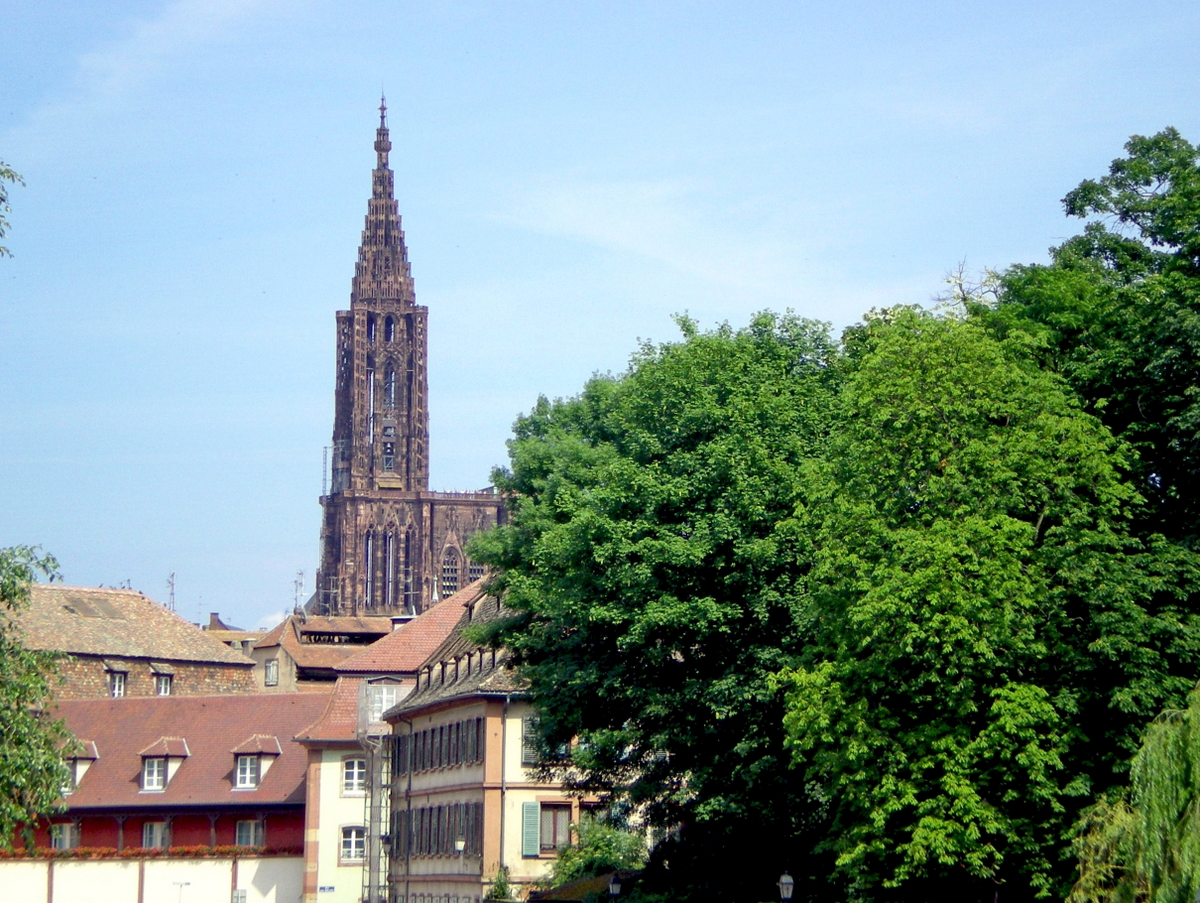
French-style Gothic!
The nave, for example, not only followed the Ile de France’s gothic style (French Gothic) but dared to go even further by adopting the most popular trends of gothic style in France.
Unlike in other buildings in Germany, the builders of the Cathedral of Strasbourg did not include architectural elements particular to the region. This was also the case for the magnificent façade, the construction of which was undertaken shortly after the completion of the nave.
Here, you will find a decoration that is also present on the façade of the Cathedral of Troyes, the “harp strings”, which were particularly well-represented in Strasbourg.
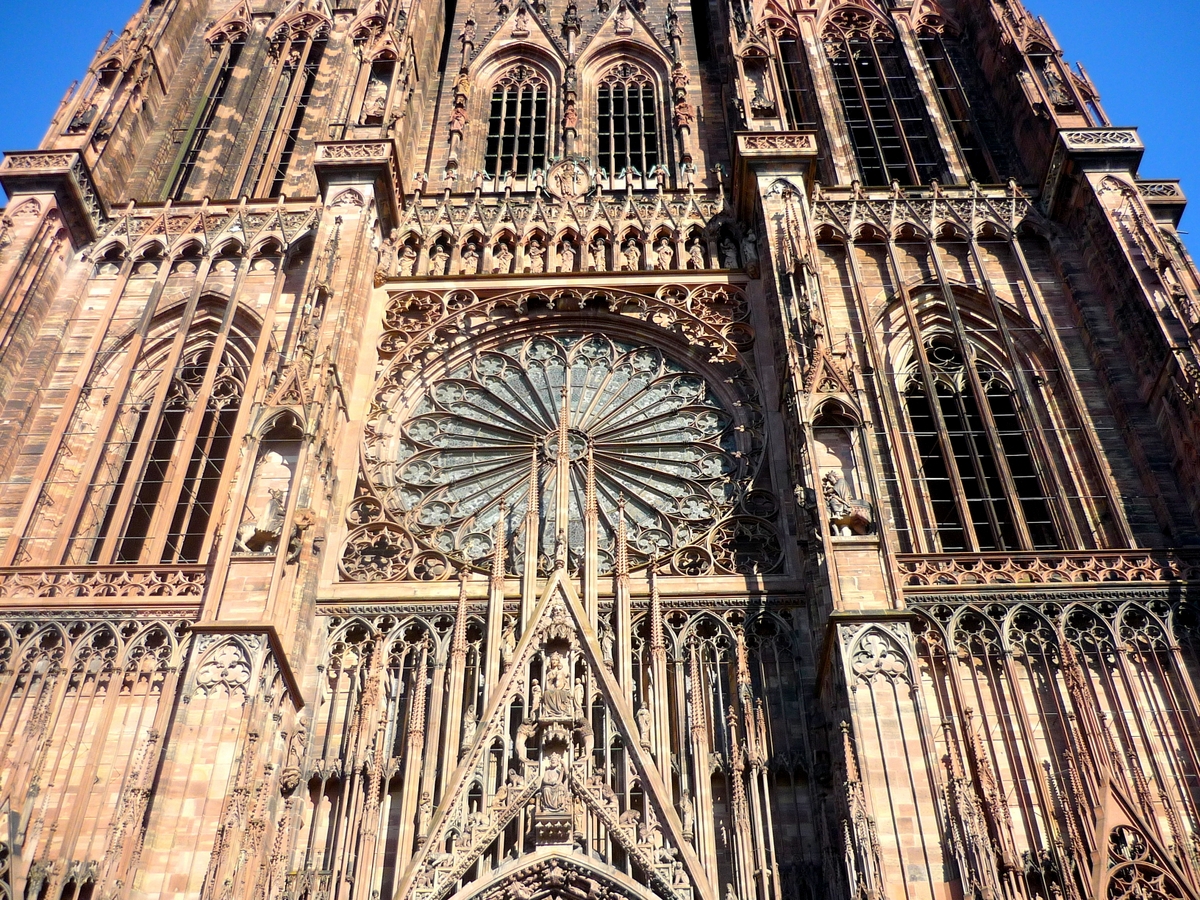
A slow-building process
The lack of money for the cathedral’s funding is one of the reasons for its slow progress. The Bishop thus had to recourse to indulgences in 1253 to finish the nave.
If the French brought their influence to gothic art (red and blue stained glass windows), the Germanic world knew how to impose its ideas (stained glass windows including the colour green).

Humanism and the Reformation
The 16th century marked a turning point for Strasbourg and its cathedral following the eruption of Humanism and the Reformation.
In 1518, the Theses of Luther were attached to the cathedral doors, and printing houses – which had a strong presence in the town thanks to Gutenberg – accelerated the propagation of the emerging Protestant faith.
From 1524, the town was firmly convinced by the ideas of the Reformation and its churches were allocated to the Protestant faith.
Strasbourg, a Free City
Strasbourg, the Free City of the Empire, thereby taunted the authority of Emperor Charles V (a Habsburg and faithful Catholic). The cathedral was not returned to the Catholic faith until 1681, following the Wars of Religion of the 17th century and the annexation of the city by Louis XIV.
From Goethe to the Gothic Revival in the 19th c
Goethe glorified the cathedral throughout his stay in Strasbourg in 1770-1771. The German writer paved the way for a wave of re-evaluation of gothic art in Europe. In 19th century France, Victor Hugo was known as the instigator of this revival of interest, inspiring the architect Viollet-le-Duc and thus saving Notre Dame de Paris from ruin.
A note about the lantern tower!
By looking at the Romanesque-style lantern tower at the transept crossing, you may think it is an old feature. In fact, it only dates back to 1878 and is the work of Gustave Klotz. The form of the neo-Romanesque tower evokes other great Romanesque cathedrals of the Valley of the Rhine (Speyer or Mainz). In addition, bombings during the Second World War severely damaged the structure.
The majestic façade of Strasbourg cathedral
“The more I contemplate the façade of the cathedral, the more I am convinced of my first impression that its loftiness is linked to beauty”.
Goethe
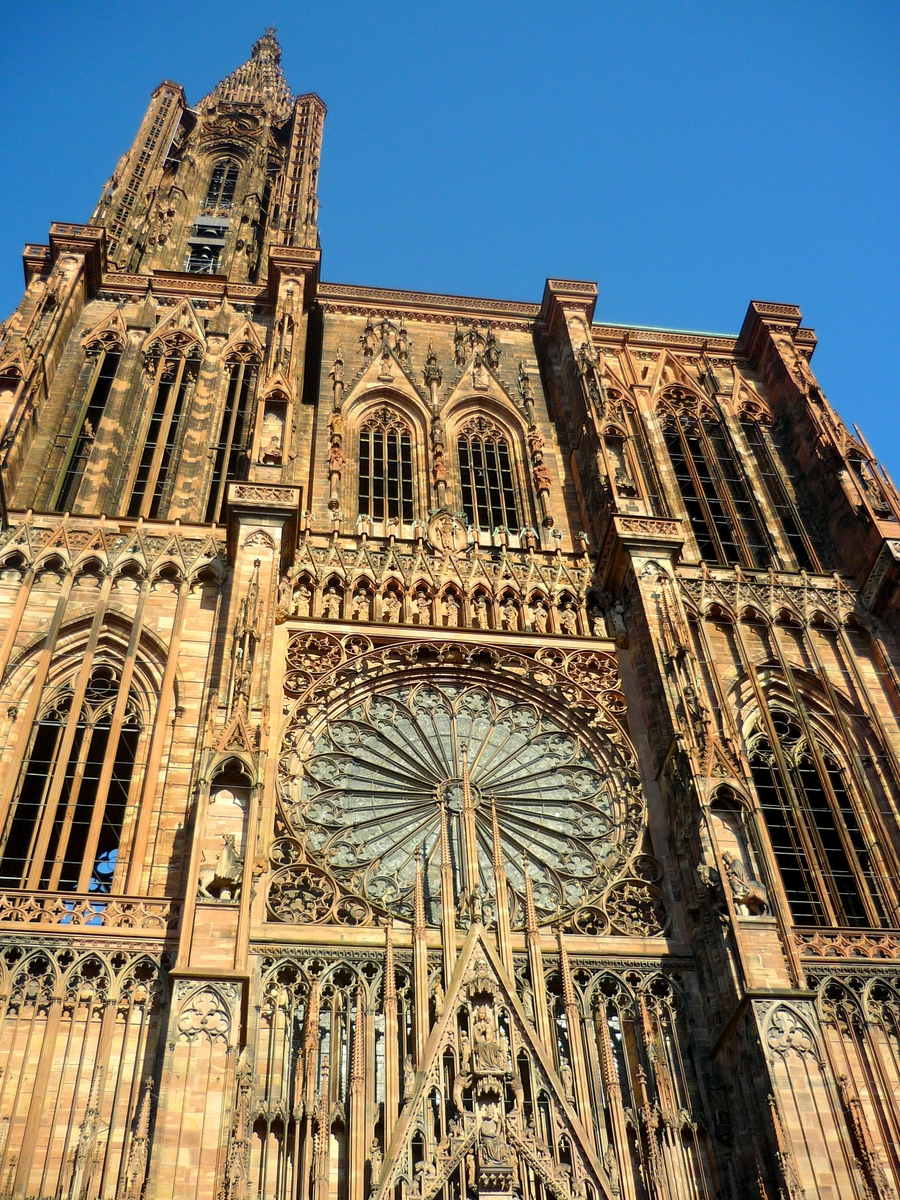
The best position to get an overall view of the magnificent façade is from Rue Mercière. The richly decorative façade is still striking today. The most successful example – and unique in France – is the “curtain” made of stone harps fixed in front of the load-bearing walls.
The tympana of its three doors, surmounted by a double gable, is dedicated to the life of Christ.
The central Portal
This is the façade’s most richly decorated portal. The statues of the prophets of the Old Testament are represented here in the five arches of the portal. These characters are supposed to be the link between ancient and modern times and, as such, are guarantors of the accurate unfolding of history.
In the four historiated registers, you can read scenes from the Old and New Testament, with the Passion of Christ as the central theme at the centre of the collection, and a statue of the Virgin With Child personifies Universal Wisdom (Sophia of the Greeks), the axis around which everything is ordered. Another statue of the Virgin is located above the tympanum, which itself is surmounted by a statue of Christ, King and Judge, whose throne is surrounded by musical lions.
The left Portal
The arches of the north portal are decorated with majestic and graceful 14th-century statues representing the virtues, striking down the vices, and, around the tympanum, by angels and other biblical characters. The subject of the register of the tympanum is the Childhood of Christ (his birth, fleeing to Egypt, and Presentation at the Temple).
The right Portal
This illustrates the parable of the Wise and Foolish Virgins. Five Wise Virgins each carry a lamp and the open Table of Law, and beside them is the ideal husband. As for the Five Foolish Virgins, they are holding their lamps upside down, clutching the Tablet of Law closed, and beside them is the Tempter holding the apple of temptation with reptiles on his back. From a logical standpoint, the register of the tympanum depicts the Last Judgement.
The Great Rose Window and the Gallery of Kings
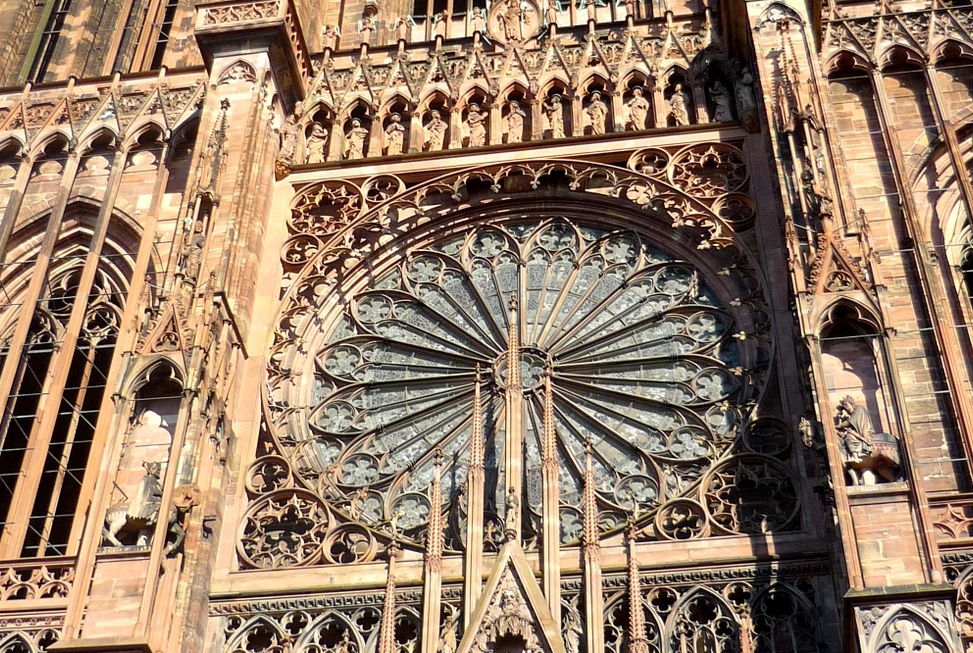
Above the tympana is the magnificent Rose Window by Erwin von Steinbach. It constitutes the central point of the façade. This piece of work (15 metres in diameter) is unique. Unlike the Gothic tradition of featuring Saints, it shows ears of wheat instead. They symbolised the commercial power of Strasbourg in the Middle Ages.
Above the rose window is the Gallery of Apostles. This is the point of honour of the rich statuary that characterises the façade. During the Revolution, all the statues were ordered to be destroyed. More than 230 were damaged. However, this number could have been much higher if an administrator of public property had not managed to hide 67 of them!
In the niches of the first and second-floor galleries, you can see equestrian statues of twenty monarchs, from Clovis I until Louis XIV. Not surprisingly, these statues were the first to suffer the torments of the Revolution. They were destroyed and later replaced in the 19th century.
The Spire of Strasbourg Cathedral
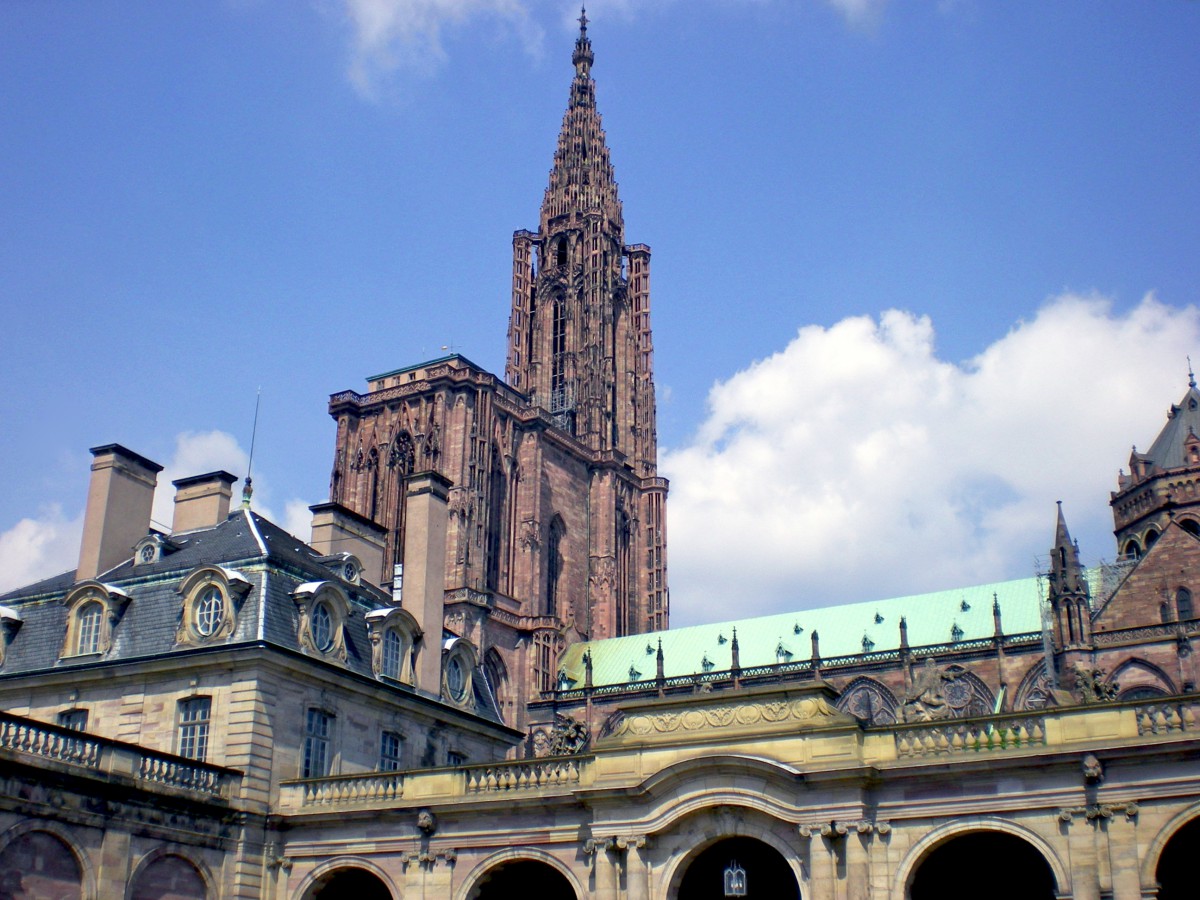
The cathedral’s single bell tower and its magnificent spire have symbolised the city of Strasbourg for several centuries. As mentioned above, the spire extends to 142 metres in height. It remains Europe’s tallest medieval structure because even though the height of the cathedrals of Cologne (157m) and Ulm (161m) in Germany and that of Rouen (151m) in France exceed the record held by Strasbourg from 1647 to 1874, the construction of their towers only dates back to the 19th century.
In comparison, the towers of Notre Dame in Paris reach 69m, and the spire of the transept crossing, built by Viollet-le-Duc in the 19th century, stands at 96m high.
The cathedral’s unusual silhouette is due to several plan changes in its construction history.
Four projects for a grand cathedral!
There were several project plans, and four diagrams – A, B, C, and D – were worked on by the cathedral’s famous architect, Erwin von Steinbach.
Project A is one of the oldest preserved architectural designs in the Western World, dating from the 1260s.
Project B is modelled on the façade of the Cathedral of Troyes (2 towers, 3 portals and a second storey with a central rose). It is finished by surpassing it in the new and abundant elaboration of gothic forms.
The original plan of its façade by Edwin von Steinbach consisted of only two storeys and two spire-topped towers.
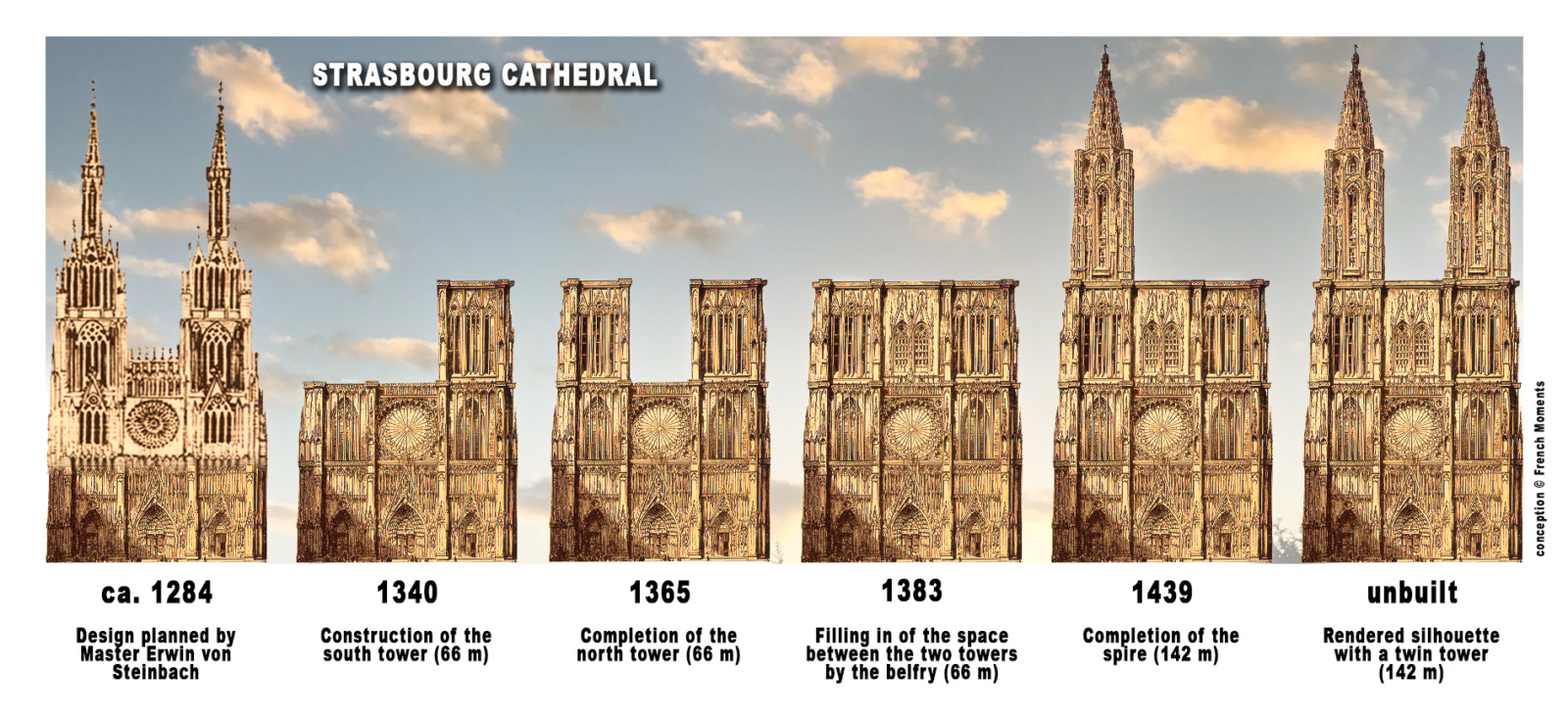
Turmoil in the 14th century
Master Gerlach continued the works between 1355 and 1365 and completed the third level of the bell tower. However, the anticipated improvement of the spires was abandoned for several reasons.
In 1356, the city of Basle and the Sundgau (South of Alsace) were destroyed by an earthquake, which may have reduced the builders’ and some traumatised inhabitants’ enthusiasm for the project.
In addition, the Great Plague of 1349 caused enormous human loss and financial difficulties for the city.
The work must go on!
So in 1365, the cathedral’s silhouette strangely resembled that of Notre Dame in Paris, and its 66-metre towers were 3 metres shorter.
Towards 1383, following Gerlach’s death, his successor, Michael of Freiburg, decided to fill in the space between the towers.
The Chief Magistrate of Strasbourg did not like the cathedral’s new silhouette, entrusting Ulrich of Ensingen with erecting an octagonal-shaped 34-metre high bell tower at the base of the North Tower.
The tower strangely resembled the Cathedral of Ulm in Germany (the tallest in the world), which the architect had also worked on. The newly bell tower-topped cathedral now reached a height of 100 metres.
A graceful spire for Strasbourg Cathedral
Ulrich of Ensingen had planned to cap the tower with a relatively simple spire. But Johannes Hültz of Cologne, resuming the task of the works, completely changed the project and created a very complex and graceful spire.
Each edge of the octagonal tower has a succession of six small hexagonal spiral staircases. These are followed by four more twisted staircases within four huge pinnacles fitted on four corners of the tower and clearly visible from the outside. The construction of the spire, at a height of 42 metres, was not completed until much later, in 1439. At this time, the Chief Magistrate was satisfied with the work because the Strasbourgeois considered the building a symbol of their city’s power and greatness.
Still waiting for a second twin spire!
On several occasions, the plan of a second twin spire for Strasbourg Cathedral was addressed. So, in 1490, architect Hans Hammer designed the plan for a second spire, but his project was unsuccessful.
This was perhaps a sign that gothic art had gone out of fashion (the Renaissance was already flourishing in Italy) or, more rationally, that the townsfolk were too poor to undertake such a task.
Other specialists believed instead that constructing a second tower on a renowned unstable ground could destabilise the building and cause severe damage.
Later in the 19th century, German architects entertained the idea of a twin spire without success… the symbol of the single-spire cathedral was already fixed in the hearts of the Strasbourgeois, in whom they saw the power of the Republic of the Free City of Strasbourg in the Middle Ages.
The Panoramic terrace and the different levels of the belfry
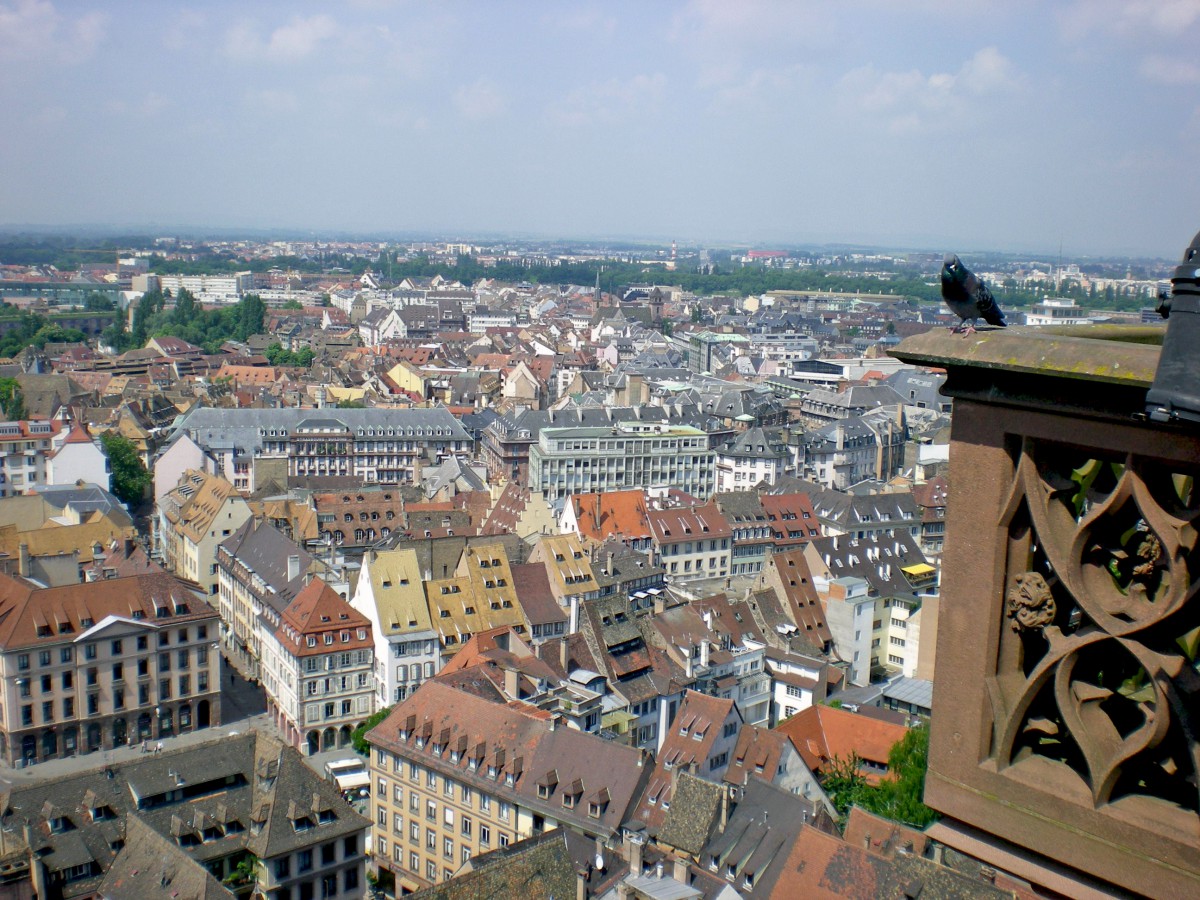
The first platform, at 66 metres high, is accessible to the public daring to climb its 330 steps. The view over the city of Strasbourg here is spectacular, and on a clear day, you can see the Alsace Plain, the Vosges, and the Black Forest (Germany). It is no longer possible to climb the extra steps of the North Tower from here.
The second platform is that of the large tower, at a height of 100 metres. It marks the end of the tower and the start of the spire.
The bells
By climbing to this platform, you can admire the flamboyant series of bells, which have one of the greatest chimes in France and, according to experts in campanology, one of the most perfect in Europe. This volley of bells is called the Torglocke or Zehnerlock (ten o’clock bell).
The Great Bell of the Cathedral
As for the most oversized clock in Strasbourg – the Great Bell – is not located in the tower but somewhat above the Great Rose Window. The Totenglocke (its name in German, which means the clock of the dead) was cast in 1427 by master craftsman Hans Gremp of Strasbourg and weighs nearly 9 tonnes. In 1982, the famous clock was listed as a historical monument object.
To the spire of the cathedral and beyond…
At 132 metres high, the platform of the spire marks the end of the spire and the start of the peak. It can only accommodate a small dozen people at any one time.
Finally, at 136 metres high, the peak’s minuscule – and final – hexagonal platform ends this ascension towards the sky.
In 1794, a Strasbourgeois capped the spire with a huge Phrygian bonnet in tinplate. For some ardent revolutionaries – the Jacobins – the spire of Strasbourg cathedral symbolised inequality and thus should have been pulled down. This was one of the ruses of protectors of the cathedral who, under the pretext of taunting the Germanic enemy by brandishing a symbol of the Revolution, avoided its destruction.
The view here is absolutely fantastic for the lucky ones who can gain permission to reach it.
My book recommendation!
Its name? Simply:
Gothic: Architecture, Sculpture, Painting by Rolf Toman, Publisher: Ullmann
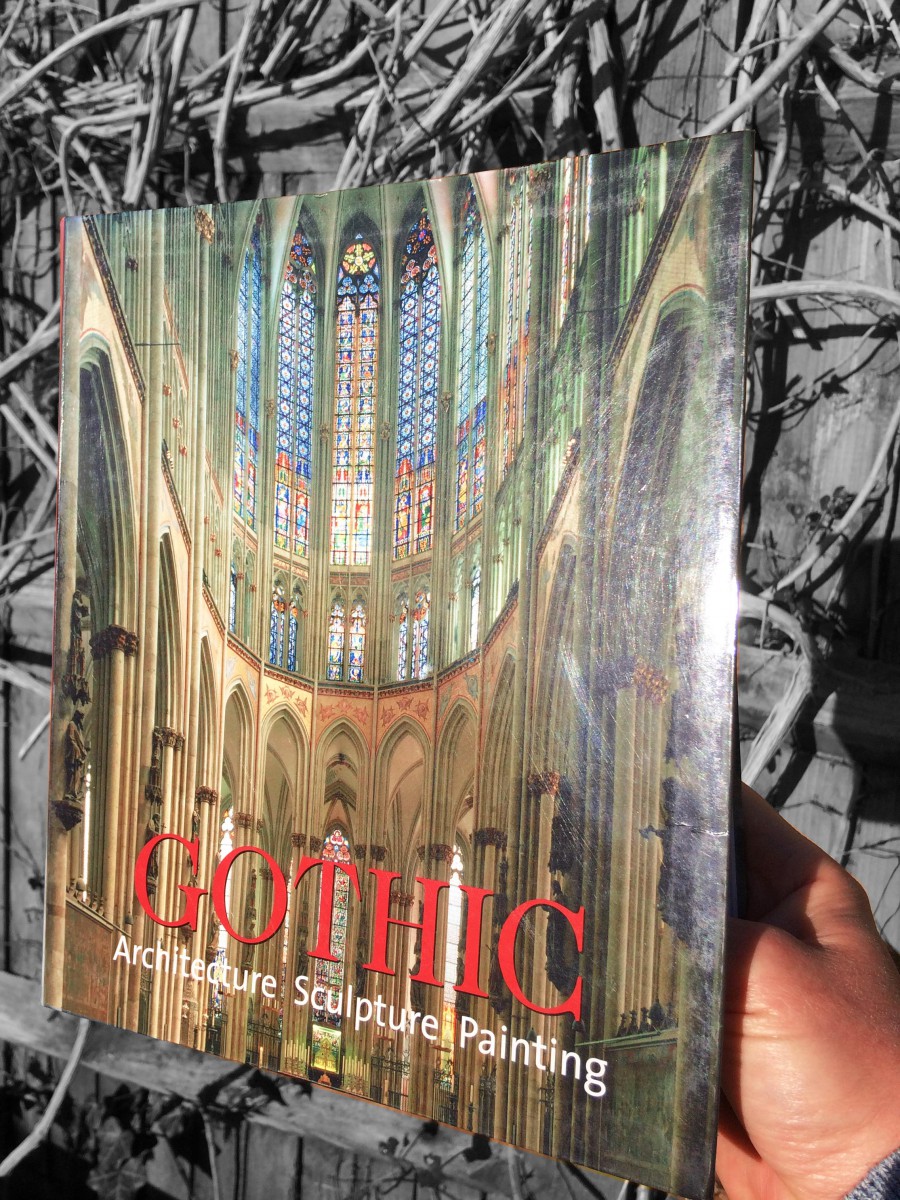
This book has been a great resource that helped me better understand the Gothic movement in art from the 12th century to the Renaissance. An architectural style that first originated in France and spread all over Europe.
Over 500 pages, it focuses on the development of Gothic architecture with many illustrations and photographs, but not only. I’ve also found the in-depth discussion of the most diverse art forms, including painting, sculpture, metalwork, and even book illumination, interesting! It also includes specific coverage of the Cathars’ Heresy and the Papal Palace in Avignon. And, of course, it mentions the Notre Dame de Strasbourg cathedral!
This is the book I recommend if – like me – you love everything about Gothic, such as churches, gargoyles, stained glass, flying buttresses, and so much more.
The Transept (exterior)
The South lateral Portal of the Transept
The south lateral portal of the transept is one of the oldest visible parts of the Romanesque style in the cathedral.
It is flanked by three statues representing from left to right:
- the Church (majestic and crowned),
- King Solomon (above two other small statues of children evoking his famous judgement),
- and the Synagogue (eyes blindfolded, a sign of the refusal of true faith by the Jewish religion).
The two Romanesque tympana depict the Dormition and the Crowning of the Virgin.
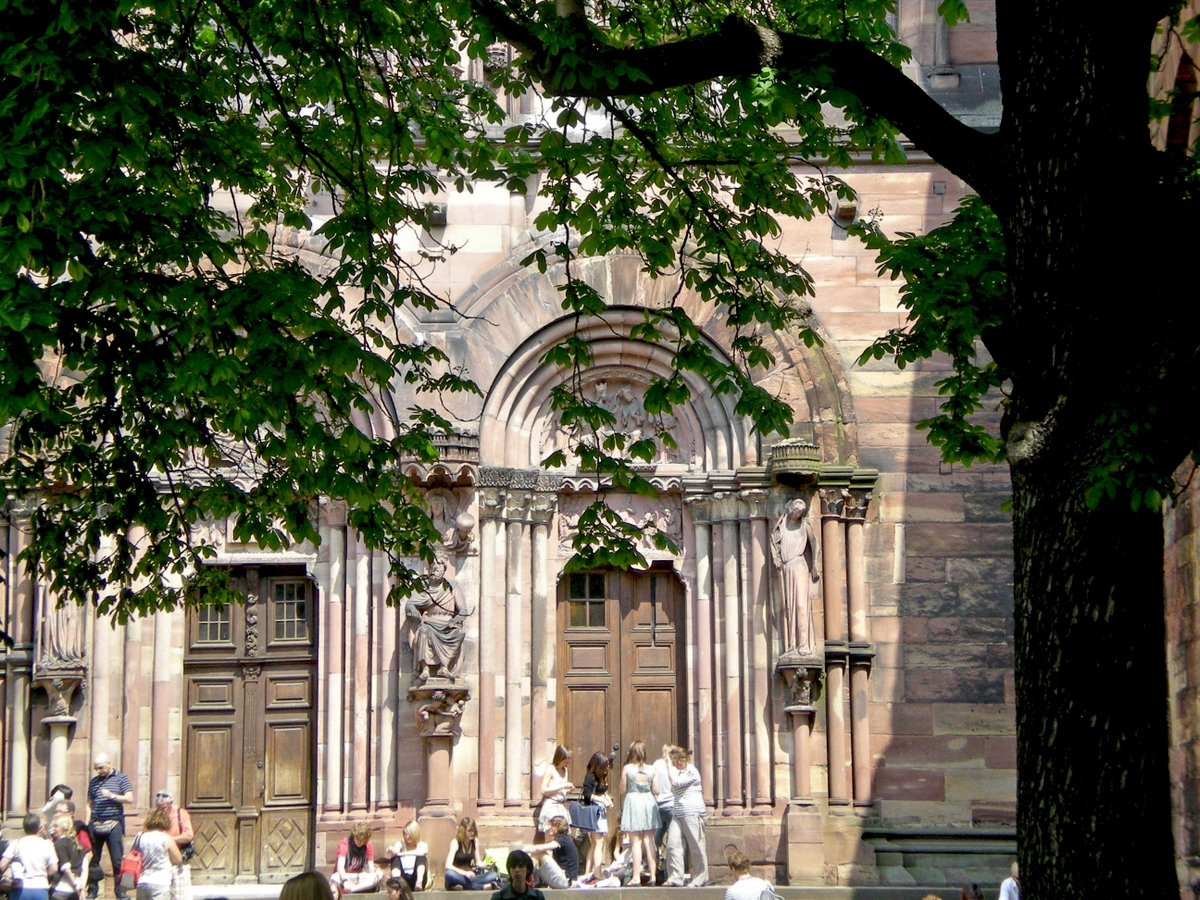
This portal acquired its nickname of “Judgement Door” in part thanks to the representation of Solomon but also because it was in this place that the Bishop of Strasbourg held his tribunal.
The very popular and subsequently famous Christmas Market initially occurred in this location.
The North lateral Portal of the Transept
The late Flemish gothic style north transept portal is more recent than the south portal.
Carried out by Johannes of Aachen, it is dedicated to St Laurent and recounts his martyrdom.
The lantern tower
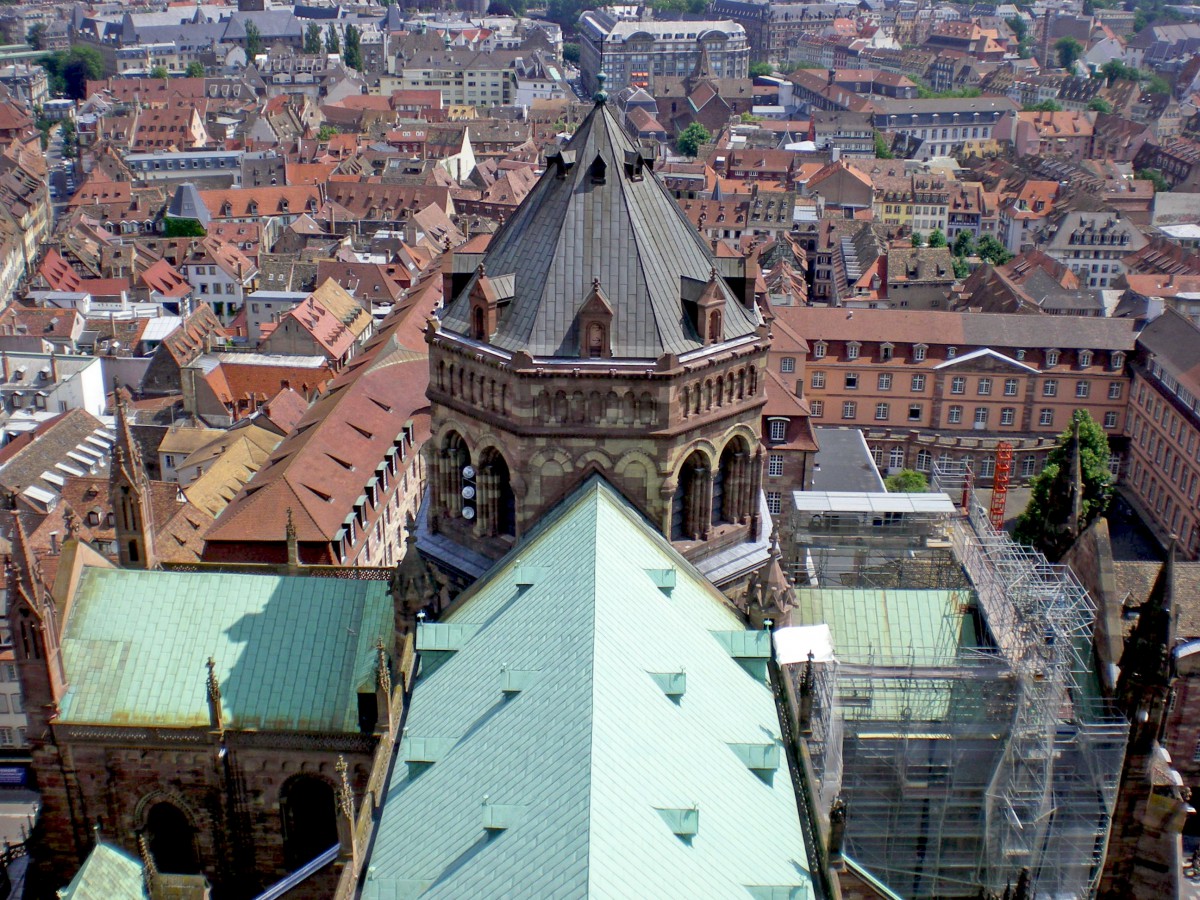
At the crossing of the transept, the Romanesque-style lantern tower dates back to 1878 and is the work of Gustave Klotz. Severely damaged during the Second World War, its forms evoke other great Romanesque cathedrals of the Rhineland, such as Speyer or Mainz.
The Nave of Notre-Dame de Strasbourg
The interior of Strasbourg cathedral is majestic, with its beautifully proportioned nave, respectful of gothic – commonly known as classic – style.
At 32 metres, the nave is taller than Rouen (28m) but remains well below that of Metz (41.4m).
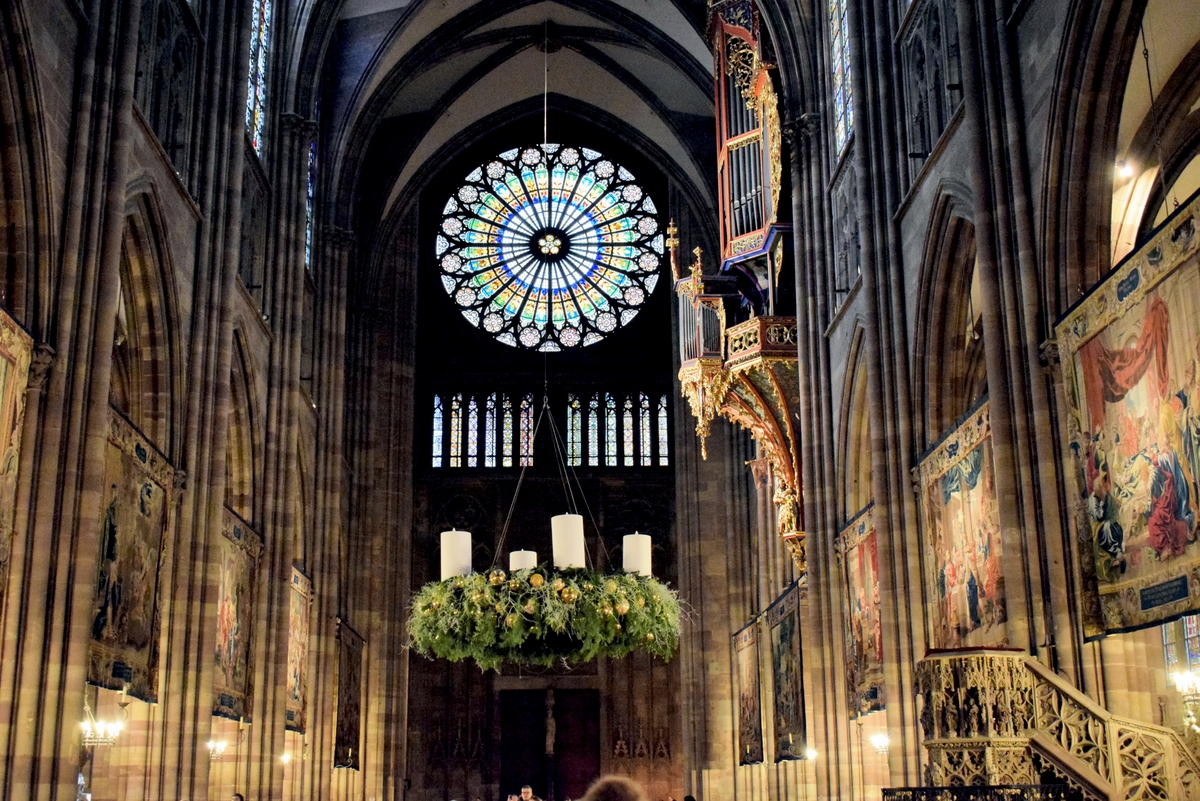
The reduced dimensions of the chancel and the 63-metre length of the nave (among the longest in France) accentuate the impression of disproportion.
The nave extends over seven spans and rises over three storeys (large arcades, triforium and high windows). It is built in radiant gothic style at 32 metres high and 36 metres wide (including collaterals). It is in this nave that the marriage of King Louis XV with Marie Leszcynska was celebrated on 4 September 1725.
The stained-glass windows of Strasbourg cathedral
The cathedral’s interior contains a rich collection of stained glass windows (more than 4,600 panels), most dating from the 12th, 13th and 14th centuries.
In the north collateral, they represent different Emperors of the Holy Roman Empire (13th century).
The triforium’s stained glass windows represent Christ’s ancestors following the genealogy of the Gospel of Luke. Those of the south lateral nave (to the right, coming from below) are in bad condition and illustrate episodes of the New Testament of the life of the Virgin Mary and Christ.
The stained glass windows of the nave depict the life of the Saints.
![Stained-glass window in Strasbourg Cathedral © Tilman2007 licence [CC BY-SA 4.0 from Wikimedia Commons]](https://frenchmoments.eu/wp-content/uploads/2023/12/Stained-Glass-Window-South-Aisle-Strasbourg-©-Tilman2007-licence-CC-BY-SA-4.0-from-Wikimedia-Commons.jpg)
The Great Rose Window
Finally, behind you, you can admire the Great Rose Window above the grand portal. Its round shape expresses at once the image of the cosmos, the Earth, and the Sun – often seen as a symbol of God watching over his creation.
The role of the stained glass windows was to help illustrate the stories the preachers told from their pulpits for those who did not know how to read, in the same way as a comic strip. It was the “poor man’s Bible”, a succession of small, fairly easily identifiable pictures for the people of the time.
The Great organ
Heading back towards the nave from the portal, visitors discover the great organ hanging in the bird’s nest in the triforium to their left. Its 14th-century buffet extends across an entire span of the nave.
The pulpit of Geiler von Kaysersberg
Two naves span further away, and you’ll see the magnificent hexagonal pulpit in flamboyant gothic style, featuring the sculpture of some fifty small figurines. This work by Hans Hammer for the preacher Geiler of Kaysersberg is no longer in use today for practical reasons. From here, Bible readings read during mass were explained and discussed.
This very richly decorated pulpit expresses, in the magnificence of its sculptures, the essential importance of the Bible, the words of which must be announced until the ends of the earth. Notice the small sculpture of a dog on the stairs. It depicts when Geiler of Kaysersberg came to preach on this pulpit, accompanied by his dog.
The Transept (interior)
In the south arm of the transept are two particularly remarkable elements: the Pillar of Angels and the Astronomical Clock.
The Pillar of Angels of Strasbourg Cathedral
The Pillar of Angels, an architectural prowess at the time of its construction around 1230, serves as the central pillar of the south transept. It features twelve sculptures: the four evangelists, angels playing the trumpet, and, further up, Christ the Judge, seated, serene, and benevolent, surrounded by angels carrying the Instruments of the Passion. The pillar is also called the “Pillar of Last Judgement” because it stages the judgement mentioned in the Book of Revelation.
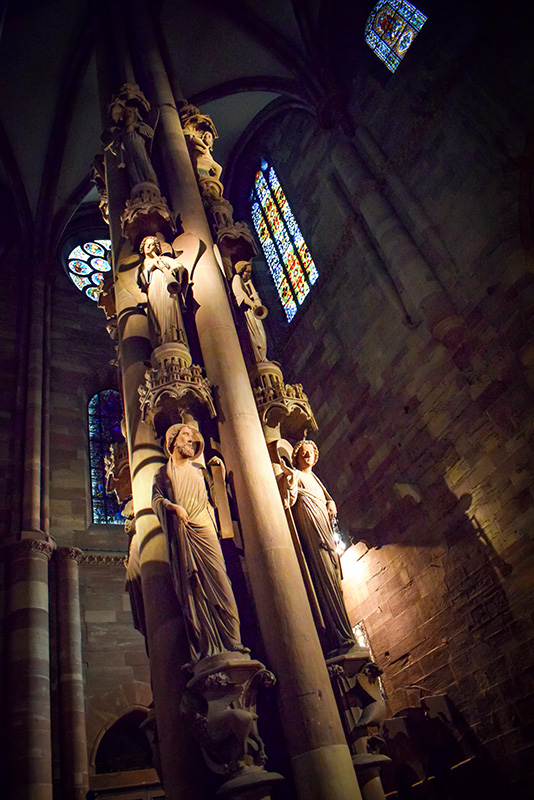
Close to the pillar, note the statue of a man leaning on a railing. This would be a jealous architect competitor who predicted that such a pillar could never support the archway. He declared that he would wait for the structure to collapse to prove the integrity of his conviction. He is still there, waiting…
The Astronomical Clock of Strasbourg Cathedral
The enormous and complex Astronomical Clock of Strasbourg Cathedral is a Renaissance piece in the right brace of the transept. Sculptors, painters, technicians, mathematicians and Swiss watchmakers worked together on this wonder that is extremely popular among visitors to the cathedral: the number of visitors coming to admire its mechanism is estimated at 3 million. This incredible masterpiece tells of the pride the Strasbourgeois feel in counting their cathedral among the seven wonders of Germany.
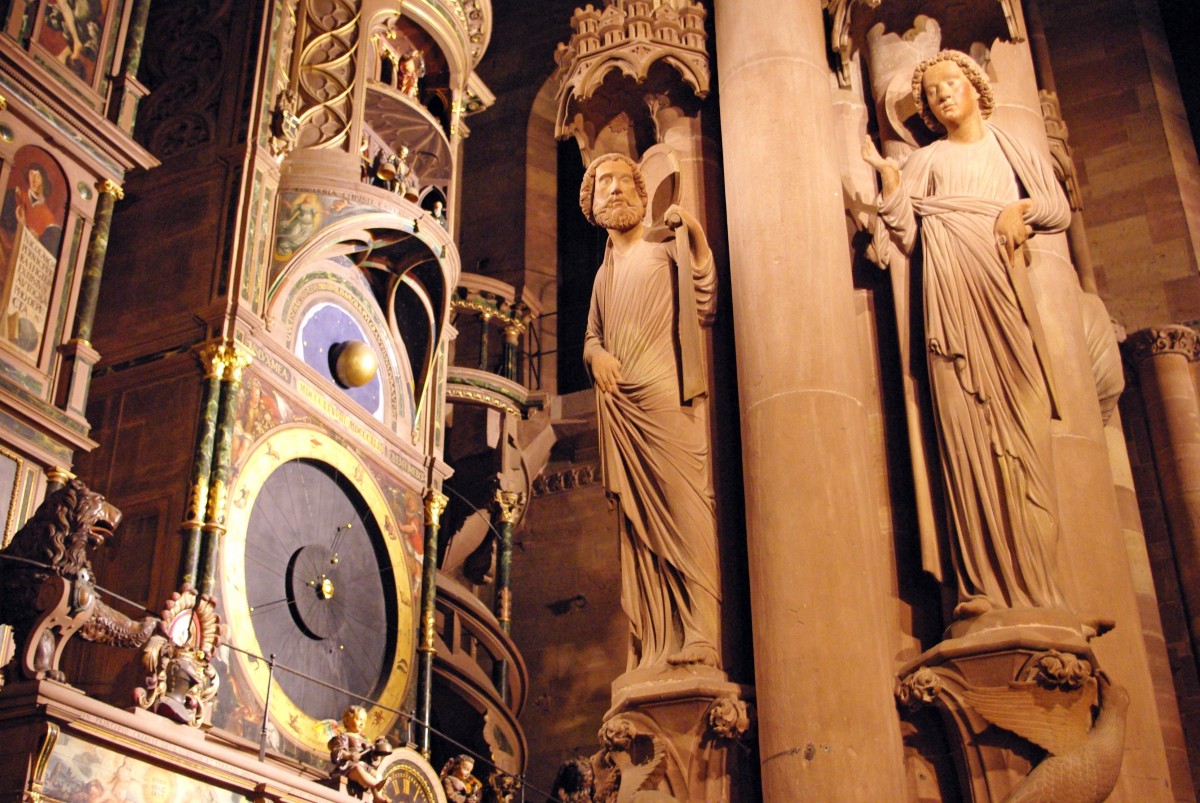
A mechanism from the 19th C
The current mechanism dates from 1842. The first clock was completed in 1571 with the same Renaissance-style buffet, animated decorations, and characters. Its mechanism stopped working one day in 1788, and it remained “mute” for several years until 1838, when the task of repairing it was entrusted to an Alsatian, Jean-Baptiste Schwilgué (1776-1856).
Self-taught, this 61-year-old former apprentice watchmaker-turned-professor of mathematics and auditor of weights and measures had wanted to devote himself to the reparation of the clock with a very complex mechanism since childhood.
For 30 years, he examined the mechanism and tried to understand the reasons for its breakdown. The clock’s mechanism was entirely recreated thanks to Schwilgué’s knowledge, notably in clock wheel manufacturing.
A complex and fascinating design
From the end of the works in 1842 until today, the fascinating Astronomical Clock of Strasbourg provides the time, the civil and ecclesiastic calendars, as well as astronomical indications such as the sign of the zodiac, the lunar phase and the position of many planets.
The seven days of the week are indicated by deities in chariots: Apollo (Sunday), Diana (Monday), Mars (Tuesday), Mercury (Wednesday), Jupiter (Thursday), Venus (Friday), and Saturn (Saturday). Looking closer, you can see that Saturn is depicted devouring one of his children, which is interpreted as time destroying what it produces.
The weekly maintenance of the clock is carried out by a watchmaker every Monday.
The astronomical clock of Strasbourg: a top-rated attraction
It is its set of mechanical figures that nonetheless attracts visitors. These are set in motion every fifteen minutes, but the complete display of animated characters occurs daily at noon in Strasbourg – 12.30 in France!
An angel rings a bell while a second one turns over the hourglass. At the same time, four characters representing the four ages of life (infant, young man, adult and old man) march past Death. On the top level of the clock are the Twelve Apostles, who march before Christ, bowing to him. Christ blesses them, and the rooster perched on the left tower flaps its wings while crowing three times (an allusion to Peter’s denial in the Gospels).
Several years ago, the Clock presentation to visitors was entirely reconsidered. A film projected on a screen beside the Clock in French, German, or English presents the curiosity and its history.
A word of advice: given the Clock’s popularity, it is better to arrive more than half an hour before the triggering of the mechanism, i.e. before midday. A small entry fee will be required, except on Sundays and holidays when access to the clock is accessible after the 11 o’clock mass.
The Chancel of the Cathedral
The Romanesque chancel is elevated from the rest of the nave and the transept because it is situated above the crypt. Its cul-de-four cupola is decorated with neo-byzantine frescoes dating from the 19th century. It is Eastward-facing, towards Jerusalem, as was the tradition in constructing cathedrals in the Middle Ages (as with Notre-Dame in Paris and the cathedrals of Metz and Rouen).
The European stained-glass window
The stained glass window placed at the centre of the chancel is contemporary and was given by the Council of Europe in 1956 to replace the old one, which was destroyed during the Second World War. It represents the Virgin dressed in blue. Seated on her lap, Baby Jesus wears a red outfit (a symbol of royalty), and in his hand, he holds a lily, an emblem of the city of Strasbourg. The upper part of the stained glass window features the flag of the European Union: twelve gold-coloured stars on an azure blue background.
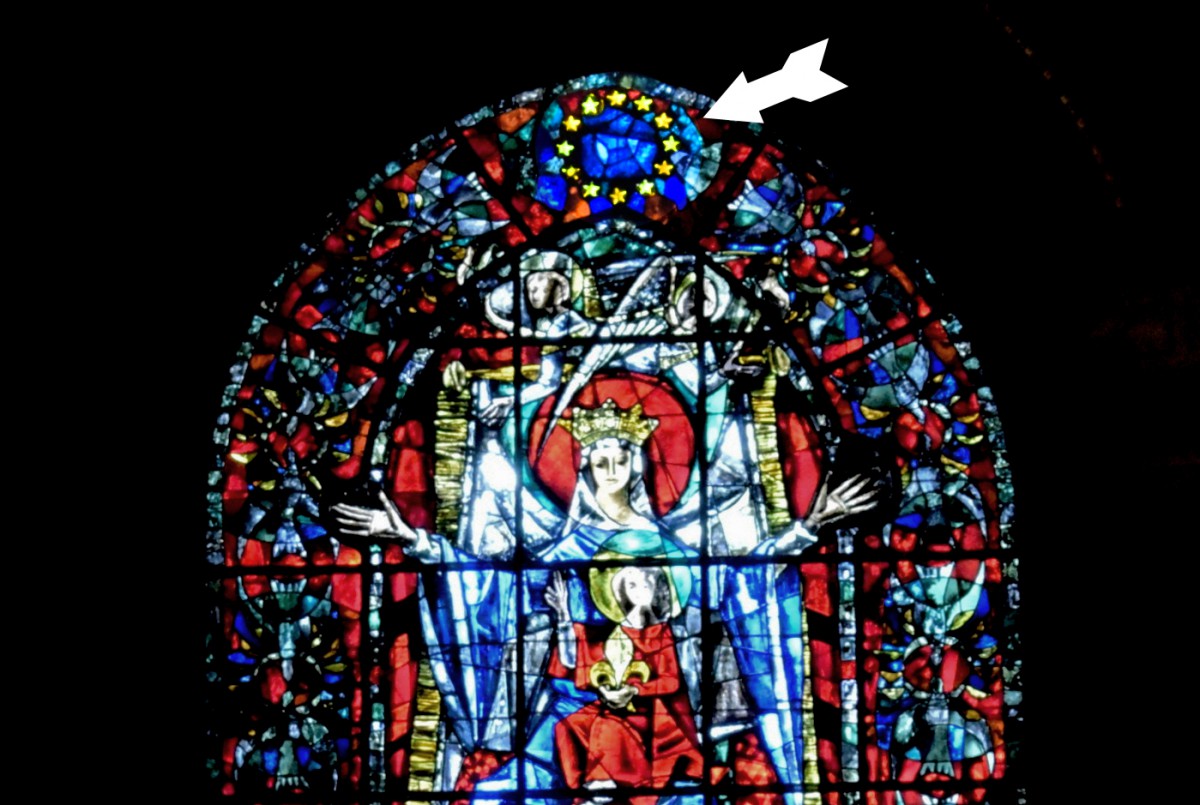
At the heart of the chancel are twelve busts representing the Twelve Apostles. Contrary to custom, the apostle replacing Judas, Matthias, is replaced by the Apostle Paul.
The Crypt of the Cathedral
Situated beneath the chancel, the crypt is, as with many gothic cathedrals, the oldest part of the building and part of the space where the remains of the ancient basilica erected by Werner of Habsburg in the 11th century are found. The crypt contains the vaults of the bishops of Strasbourg in an arena covered by groined vaults. These rest on an alternation of columns and pillars, whose capitals are roughly sculpted with fabulous plant and animal motifs.
Practical Info
Scheduled visiting hours inside Strasbourg cathedral have been established to respect this place of worship: on weekdays between 10 am and 5.30 pm and Sundays between 12.30 pm and 6.30 pm.
Visit the official site of Strasbourg Cathedral.
Visit the cathedral at Christmas
The cathedral of Strasbourg is a top-rated attraction in Advent. Read our dedicated guide to discover the giant Nativity Scene, the Nativity stained-glass window from the 14th century, the giant Advent wreath, and the 17th century-tapestries.
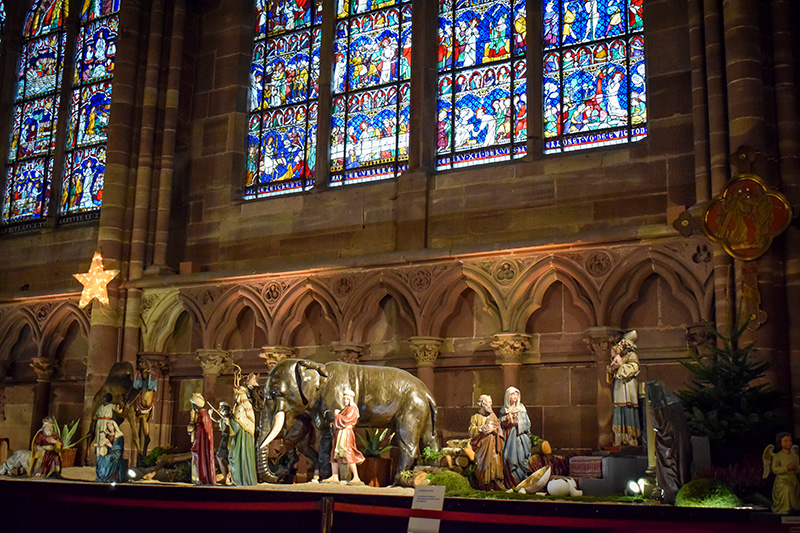
Did you know?
International car rental comparison site EnjoyTravel.com has published its 2021 list of the most beautiful places in France, according to photographers. Among these picturesque places is the cathedral of Notre Dame of Strasbourg.
Where to stay in Strasbourg
This map will help you find your accommodation in Strasbourg according to location and prices:


